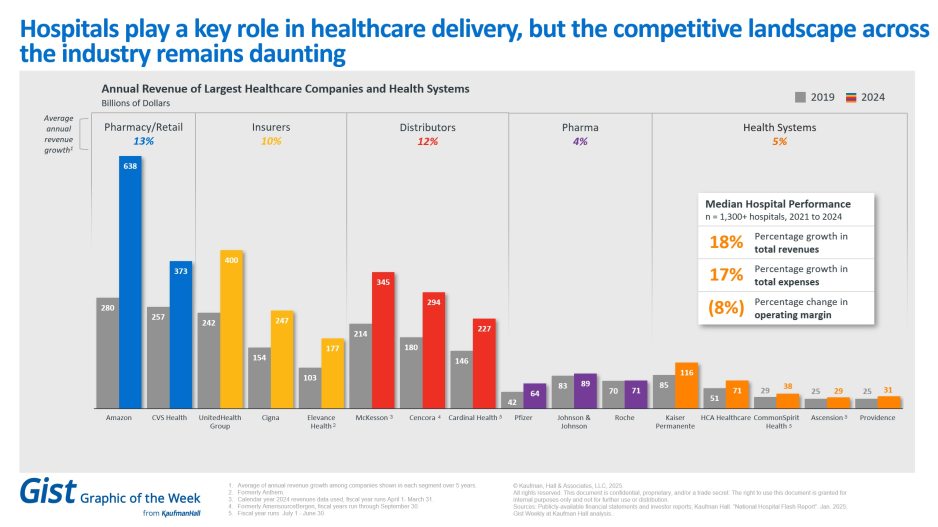Thursday Report

Happy first day of Spring!
From Washington, DC,
- Per Becker’s Health IT,
- The American Hospital Association and Health-ISAC are alerting hospitals to a social media post alleging plans for a coordinated, multi-city terrorist attack on healthcare facilities in the coming weeks.
- The organizations said they are sharing the information as a precaution and remain in close contact with the FBI. They plan to provide updates as more details emerge, according to a March 20 news release.
- The AHA and Health-ISAC said there is no information available to corroborate or discount the threat’s credibility.
- “Generally, foreign terrorist groups do not publicize their upcoming attacks. However, this widely viewed post may encourage others to engage in malicious activity directed toward the health sector, so threats of this nature should be taken seriously,” the news release reads. “Security teams should review emergency management plans and spread awareness of the potential threat internally.”
- Health Affairs Forefront offers reflections on the 15th anniversary of the Affordable Care Act, which will be marker on March 23, and an idea about how to add high deductible plans with health savings accounts to marketplace plans, which in the FEHBlog’s view is a great idea.
- The American Hospital Association News tells us,
- The Equal Employment Opportunity Commission and the Department of Justice yesterday announced the release of two documents warning against unlawful discrimination related to diversity, equity and inclusion in the workplace. A one-pager, “What To Do If You Experience Discrimination Related to DEI at Work,” and a Q&A, “What You Should Know About DEI-Related Discrimination at Work,” are based on Title VII, existing EEOC policy and Supreme Court precedent.
- “DEI is a broad term that is not defined in Title VII of the Civil Rights Act of 1964,” the agencies said. “In the past five years, DEI policies, programs, and practices have become increasingly prevalent in many of our nation’s largest and most prominent businesses, universities, and cultural institutions. The widespread adoption of DEI, however, does not change longstanding legal prohibitions against the use of race, sex, and other protected characteristics in employment.”
- and
- The Food and Drug Administration today issued an alert on a potentially high-risk issue with Calyxo CVAC Aspiration Systems. In patients who have thick fluid in their kidneys at the start of the procedure, the system can cause reduced fluid overflow, potentially leading to excessive pressure in the kidneys. Serious death or injury could occur if the increased pressure is not addressed. Calyxo has reported one death associated with the issue.
- The Food and Drug Administration today issued an alert on a potentially high-risk issue with Calyxo CVAC Aspiration Systems. In patients who have thick fluid in their kidneys at the start of the procedure, the system can cause reduced fluid overflow, potentially leading to excessive pressure in the kidneys. Serious death or injury could occur if the increased pressure is not addressed. Calyxo has reported one death associated with the issue.
- Per an HHS news release,
- “Today, under the leadership of U.S. Department of Health and Human Services Secretary Robert F. Kennedy, Jr., the U.S. Food and Drug Administration unveiled the Chemical Contaminants Transparency Tool (CCT Tool), an online searchable database providing a consolidated list of contaminant levels (e.g., tolerances, action levels, and guidance levels) that are used to evaluate potential health risks of contaminants in human foods. Chemical contaminants include a broad range of chemical substances that may be present in food and that have the potential to cause harm.”
- “Today, under the leadership of U.S. Department of Health and Human Services Secretary Robert F. Kennedy, Jr., the U.S. Food and Drug Administration unveiled the Chemical Contaminants Transparency Tool (CCT Tool), an online searchable database providing a consolidated list of contaminant levels (e.g., tolerances, action levels, and guidance levels) that are used to evaluate potential health risks of contaminants in human foods. Chemical contaminants include a broad range of chemical substances that may be present in food and that have the potential to cause harm.”
- The President today signed an executive order implementing the following policy,
- “The Federal Government spends approximately $490 billion per year on Federal contracts for common goods and services — the types of goods and services purchased by nearly every executive department and agency (agencies) — making it the largest buyer of goods and services in the world. As a matter of sound management, these standardized procurement functions should be carried out in the most efficient and effective manner possible for the American taxpayer. The General Services Administration was established in 1949 through the Federal Property and Administrative Services Act, 40 U.S.C. 101 et seq., to provide “an economical and efficient system” for the core procurement services for agencies (40 U.S.C. 101). It is time to return the General Services Administration to its original purpose, rather than continuing to have multiple agencies and agency subcomponents separately carry out these same functions in an uncoordinated and less economical fashion.”
- Federal News Network discusses the EO here.
- Bloomberg Law reports,
- “The US Agriculture Department is preparing to spend as much as $100 million to combat bird flu by soliciting proposals for new poultry vaccines and virus detection methods.
- “Officials plan to announce the funding opportunity for companies including vaccine manufacturers on Thursday, according to a USDA email obtained by Bloomberg Government and verified by two congressional staff granted anonymity to discuss the not-yet-public plan.
- “The solicitation announcement is expected to seek proposals that prevent, treat, or research bird flu infections, according to the Wednesday email signed by Tucker Stewart, the deputy assistant secretary for USDA’s Office of Congressional Relations.
- “The money would be the agency’s latest step toward rolling out a $1 billion bird flu response plan that Agriculture Secretary Brooke Rollins announced in February. Rollins has downplayed the role vaccines will play in fighting the virus since announcing the strategy, citing high costs and low effectiveness rates.”
From the public health and medical research front,
- NBC News informs us,
- “Prescriptions for ADHD medications have been spiking in recent years, with the sharpest increase among middle-aged and older women. They’re also the least likely to misuse the prescription stimulants, a new study found.
- “The rise among women ages 35 to 64 has been substantial. At the end of 2022, 1.7 million women in this age group were prescribed stimulants such as Adderall and Ritalin for ADHD, compared to 1.2 million prescriptions in 2019.
- “There’s been an overall jump in ADHD prescriptions since the pandemic and the rise of telehealth. The new analysis, published in JAMA Psychiatry by researchers at the National Institute on Drug Abuse, also looked into how the medications are being misused — that is, taking more of the drugs than prescribed, taking them at times that differed from what the doctor ordered or using medication from someone else’s prescription.”
- Cardiovascular Business points out,
- “Using cannabis significantly raises a person’s myocardial infarction risk, even if they are young and otherwise quite healthy, according to the research team behind two new studies. The first is a retrospective analysis that was just published in JACC Advances, while the other is a meta-analysis being presented at ACC.25, the American College of Cardiology’s annual conference.
- “Asking about cannabis use should be part of clinicians’ workup to understand patients’ overall cardiovascular risk, similar to asking about smoking cigarettes,” Ibrahim Kamel, MD, clinical instructor at the Boston University Chobanian & Avedisian School of Medicine and the lead author of both studies, said in a statement. “At a policy level, a fair warning should be made so that the people who are consuming cannabis know that there are risks.”
- “Kamel et al. performed a retrospective study of more than 4.6 million adults 50 years old or younger. All participants were free of significant cardiovascular comorbidities with no prior coronary artery disease. The average follow-up period was more than three years. Overall, the group found that cannabis use significantly increased a person’s risk of a myocardial infarction, ischemic stroke, heart failure and cardiovascular death.”
- Per Healio,
- “Markers of subclinical heart damage were observed among individuals who smoke cigarettes, even decades after quitting, according to a study published in the Journal of the American College of Cardiology.
- “New data from the Cross-Cohort Collaboration-Tobacco Work Group showed that cigarette smoking was associated with elevated markers of inflammation, thrombosis and atherosclerosis, all of which decreased after cessation, except for coronary calcium, which remained elevated 30 years later.
- “Understanding the mechanisms of smoking-related injury and the most sensitive biomarkers of subclinical harm is critical to clinical trial planning and tobacco regulatory policy, and might be important for planning studies and informing regulatory of new and emerging tobacco products as well,” Michael J. Blaha, MD, MPH, professor of medicine and director of clinical research at the Ciccarone Center for the Prevention of Cardiovascular Disease at Johns Hopkins Medicine, told Healio. “The degree to which new and emerging tobacco products affect these same biomarkers will need to be explored.”
- On the bright side, the Wall Street Journal illustrates how “Drug Overdoses Are on the Decline, in Charts. Fatalities from drugs including fentanyl are down from recent peaks.”
- The AP reports,
- “Nestle USA is recalling certain batches of its Lean Cuisine and Stouffer’s frozen meals for possible contamination with “wood-like material” after a report of potential choking.
- “The recall applies to limited quantities of meals with best-before dates between September 2025 and April 2026. They include Lean Cuisine Butternut Squash Ravioli, Lean Cuisine Spinach Artichoke Ravioli, Lean Cuisine Lemon Garlic Shrimp Stir Fry and Stouffer’s Party Size Chicken Lasagna. The products were distributed to major stores in the U.S. between September 2024 and this month. No products beyond those listed are affected.
- “Nestle officials said they are working with the U.S. Food and Drug Administration and the Agriculture Department and investigating the source of the wood-like material. The company said it launched the recall after consumers reported the problem, including at least one potential choking incident.”
- Per Healio,
- “Adults with insulin-treated type 2 diabetes had greater HbA1c reductions and larger improvement in time in range with use of an automated insulin delivery system compared with standard care, according to findings from a new trial.”
- “Adults with insulin-treated type 2 diabetes had greater HbA1c reductions and larger improvement in time in range with use of an automated insulin delivery system compared with standard care, according to findings from a new trial.”
- Per BioPharma Dive,
- “On Wednesday, Novartis gave a more detailed look at long-awaited clinical data that the company believes will help secure a broad approval for a successor drug to its blockbuster gene therapy Zolgensma.
- “The drug, code-named OAV101, shares the same active ingredient as Zolgensma, which in 2019 gained U.S. approval for the treatment of a rare, muscle-wasting illness known as spinal muscular atrophy. Zolgensma, though, is injected into the veins, and is only cleared for use in patients under two years of age. Novartis has spent years trying to show OAV101, which is shot right into the spine, can be a safe and effective therapy for older kids.”
From the artificial intelligence front,
- STAT News reports,
- A panel of experts at a leading specialty society announced in a new clinical guideline that they have decided not to decide whether to recommend AI-assisted colonoscopies.
- “After reviewing studies and using existing information to model outcomes, experts enlisted by the American Gastroenterological Association determined that using AI definitely increases adenoma detection rate (ADR), or colonoscopies that find polyps. But they figure, with low certainty, that using AI in screening only leads to 2 fewer colorectal cancer-related deaths per 10,000 people over 10 years. Citing a close call and fuzzy evidence, the panel decided not to issue a recommendation.”
- MedTech Dive explains, “Quest, Google team on gen AI; GE Healthcare plans autonomous imaging; GE Healthcare, Synchron and robotics companies were among the medtech firms that used Nvidia’s GTC 2025 conference to share updates on their work with the AI computing leader.” For details read the article.
- RAND concludes “AI Models Are Skilled at Identifying Appropriate Responses to Suicidal Ideation, but Professionals Still Needed.”
From the U.S. healthcare business front,
- Modern Healthcare reports,
- “GE HealthCare launched its Invenia Automated Breast Ultrasound Premium system Thursday that features artificial intelligence tools.
- “The system, which has premarket approval from the Food and Drug Administration, is designed to help better detect breast cancer in women with dense breasts.
- “Detecting breast cancer in this patient population with mammography can be difficult for radiologists because both dense tissue and cancerous masses appear white in images, according to the American Cancer Society.
- “Automated breast ultrasound produces clearer and more detailed images and has been shown in multiple studies to improve the sensitivity of detecting invasive cancer in dense breasts when used alongside mammography.”
- and
- “Post-acute care technology companies Medalogix and Forcura announced their merger Wednesday.
- “The companies aim to create a platform for streamlining patient care transitions and better connect post-acute care providers to the broader healthcare system. Berkshire Partners, a Boston-based private equity firm, will be the majority owner of the combined company, which is not yet named, according to a news release. Chicago-based private equity firm The Vistria Group will be the largest minority shareholder, the release said.
- “Financial terms of the deal were not disclosed.”
- Per Fierce Pharma,
- “Optum Rx is shifting its payment models to better meet the needs of pharmacies and consumers, the pharmacy benefit manager announced Thursday.
- “The company said it will shift to a cost-based model, which will better align with “the costs pharmacies may face due to manufacturer pricing actions.” The PBM expects the change to be a positive one for the more than 24,000 independent and community pharmacies it works with, along with its members.
- “Optum said it will begin to roll out the updated models now and intends to have a full implementation in place by January 2028.”
- MedCity News lets us know,
- “Evvy, a women’s health company, is now offering fertility insights through its vaginal microbiome test, the company announced on Tuesday.
- “New York City-based Evvy is a direct-to-consumer company. Its vaginal microbiome test, starting at $129, checks for bacteria and fungi (or microbes) in people’s vaginas. After taking the test, people receive a report that explains the microbes found in the vagina and the health conditions related to those microbes. Based on the results, consumers receive a customized treatment plan and a one-on-one virtual session with a coach.
- “Now, the test results include a section on fertility insights. Users of the test receive a “protective score,” which is a measure of protective bacteria like Lactobacillus. This is associated with improved fertility, lower inflammation and better pregnancy outcomes.”
- Per BioPharma Dive,
- “Sanofi agreed to pay $600 million for a therapy in early human testing that may have the ability to “reset” a patient’s immune system and ward off debilitating inflammatory diseases.
- “The treatment, dubbed DR-0201, is known as a bispecific myeloid cell engager. It’s designed to engage specific immune cells that can prompt the body to deplete disease-causing B cells. It’s shown promise in preclinical and Phase 1 studies, Sanofi said.
- “As part of the deal announced Thursday, Sanofi agreed to pay as much as $1.3 billion more to privately held Dren Bio if DR-0201 succeeds in reaching certain development and launch goals. The French drugmaker expects to take over the DR-0201 program in the second quarter.”







